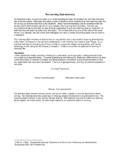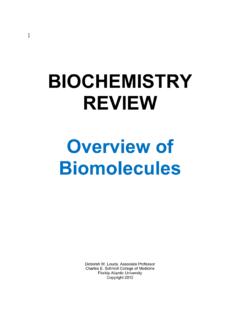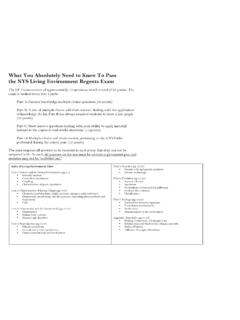Transcription of Questions with Answers- Lipids - Charles E. Schmidt ...
1 question with answers - Lipids A. The structures of different types of Lipids are studied and compared. ( Questions 1-8) Which of the following molecules is a typical fatty acid? a) A molecule that has an even number of carbon atoms in a branched chain. b) An amphipathic dicarboxylic acid with unconjugated double bonds. c) A molecule that has one cis double bond in a linear carbon chain. d) A polar hydrocarbon with that reacts with NaOH to form a salt. Which of the following structures is a 20:2 ( 4,9) fatty acid? a) CH3(CH2)9CH = CH(CH2)3CH = CH(CH2)2 COOH b) CH3(CH2)2CH = CH(CH2)3CH = CH(CH2)9 COOH c) CH3(CH2)10CH = CH(CH2)3CH = CHCH2 COOH d) CH3CH2CH = CH(CH2)3CH = CH(CH2)10 COOH Which of the following structures is a triglyceride?
2 O || a) CH2 O C (CH2)14CH3 O || CH O C (CH2)14CH3 O || CH2 O C (CH2)14CH3 O b) || CH2 C O (CH2)14CH3 O || CH C O (CH2)14CH3 O || CH2 C O (CH2)14CH3 c) CH2 O (CH2)14 COOH | CH O (CH2)14 COOH | CH2 O (CH2)14 COOH O || d) CH2 O C (CH2)14 COOH O || CH O C (CH2)14 COOH O || CH2 O C (CH2)14 COOH Which of the following is a characteristic of both triacylglycerols and glycerophospholipids?
3 A) Both contain carboxyl groups and are amphipathic b) Both contain fatty acids and are saponifiable. c) Both contain glycerol and ether bonds. d) Both can be negatively charged at cellular pH. Which of the following is a characteristic of both waxes and terpenes? a) Both can contain an amino alcohol. b) Both can contain a fatty acid. c) Both can be non-saponifiable. d) Both can contain oxygen. Which of the following structures is a sterol? a) R O b) R HO c) R O d) R HO Which is a characteristic of sphingolipids?
4 A) They all contain a fatty acid joined to glycerol. b) They all contain a long-chain alcohol joined to isoprene. c) They all contain ceramide joined to a polar group. d) They all contain a carbohydrate joined to a phosphate group. Which is a property of eicosanoids? a) All eicosanoids contain three conjugated double bonds. b) All eicosanoids contain arachidonic acid and sphingosine. c) Prostaglandins and leukotrienes both contain a ring structure. d) Thromboxanes and prostaglandins both contain a carboxyl group. _____ B. A lipid has the following structure: CH2 O CH2 (CH2)16CH3 O || CH O C (CH2)4CH=CHCH2CH=CH(CH2)7CH3 O || CH2 O C (CH2)4CH=CHCH2CH=CH(CH2)7CH3 ( Questions 9-15) Which is a characteristic of all the fatty acid components in this lipid?
5 A) They all contain an unbranched carbon chain. b) They all contain unconjugated cis double bonds. c) They all are joined to glycerol through an ester bond. d) They all are hydrophilic because they contain oxygen. What is the proper designation for the unsaturated fatty acids in this lipid? a) 18:2 ( 9,12) b) 18:2 ( 6,9) c) 17:2 ( 9,12) d) 17:2 ( 5,8) Which property does this lipid share with a typical triacylglycerol?
6 A) Both contain an ether bond. b) Both contain a long-chain alcohol. c) Both are amphipathic. d) Both are saponifiable. Which characteristic does this lipid share with a wax? a) Both contain a polar head. b) Both contain three fatty acids. c) Both contain one or more ester bonds. d) Both contain one or more carboxyl groups. Which characteristic is shared by this lipid and an eicosanoid? a) This lipid and a leukotriene are both polyunsaturated molecules. b) This lipid and a thromboxane can both be hydrolyzed in base to produce soaps.
7 C) This lipid and a prostaglandin can both be hydrolyzed in acid to create fatty acids. d) This lipid and an arachidonic acid both contain glycerol and hydrocarbon chains. Which property can be shared by this lipid and a terpene? a) Both can contain isoprene. b) Both can form micelles. c) Both can contain a saturated fatty acid. d) Both can be very hydrophobic molecules. Based on its structural similarity to other Lipids , this lipid most likely functions as a) a membrane component.
8 B) an energy storage molecule. c) a sex hormone. d) a vitamin required for vision. _____ C. The structure of an animal cell membrane is analyzed. ( Questions 16-23) Which is a characteristic of biological membranes? a) Membranes contain proteins and amphipathic Lipids . b) Membranes have an asymmetrical micelle structure. c) Membranes have hydrophobic groups on the surfaces. d) Membranes contain Lipids that polymerize into one large molecule. Which membrane lipid contains an amide bond? a) cholesterol b) phosphatidylserine c) phosphatidic acid d) sphingomyelin Which type of membrane lipid contains an acidic oligosaccharide?
9 A) phosphatidylinositol b) cerebroside c) ganglioside d) globoside Which would be a property of all the major types of Lipids in this membrane? a) They would be saponifiable in base and hydrolyzed in acid. b) They would have polar heads and non-polar tails. c) They would be composed of five-carbon units. d) They would be joined to each other through covalent bonds. Which is a characteristic of the Lipids in a biological membrane? a) Specific glycerophospholipids are distributed equally on the two membrane surfaces.
10 B) Lipid molecules are held in fixed positions by non-covalent bonds with proteins. c) The fluidity of the membrane decreases with lower levels of saturated fatty acids. d) The fatty acids of lipid molecules are found in the interior of the membrane. Which is a property of integral membrane proteins? a) All integral membrane proteins contain hydrophilic regions. b) All integral membrane proteins span the entire membrane. c) All integral membrane proteins contain carbohydrate groups within the membrane. d) All integral membrane proteins transport non-polar molecules through the membrane. Which property is shared by integral membrane proteins and peripheral membrane proteins?











